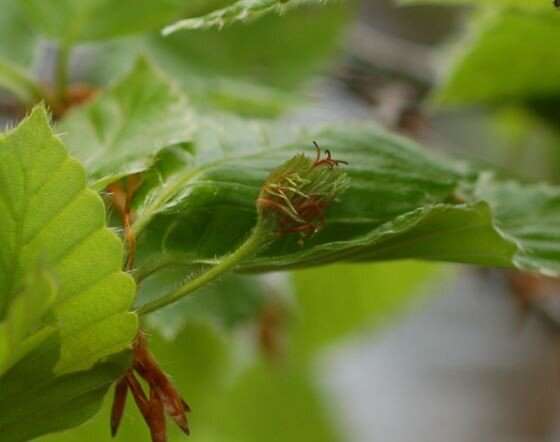Predicting bear intrusions on settlements: A 15 year beech tree flower study

In recent years, black bears (Ursus thibetanus japonicus) encounter humans in rural and suburban areas of Japan leading to the deaths and injuries of people living near mountainous areas. Unfortunately, this means the suspected bears are exterminated to prevent further casualties. It would be desirable to predict when black bears are more likely to enter human habitats to effectively warn residents to prevent possible encounters.
Professor Hideyuki Ida of the Faculty of Education, Shinshu University embarked on a 15 year study to see if the availability of beech (Fagus crenata) nuts could predict if bears feel compelled to venture into human-populated areas in search of food. To predict the beech nut harvest, he collected the male and female reproductive organs of the beech tree to see if there would be sufficient availability of food.
By showing that the fluctuation patterns of beech nut production and bears exterminated are related to a numerical model, the data can contribute to the early prediction of mass occurrence of bear intrusions.
Variables in the numerical model include the production of beech breeding organs over the years, which include female flowers, male inflorescences, and filled masts, and the number of exterminations of harmful black bears. The beech forests are the main food source for black bears.
In areas where there are many beech trees in the mountains, whether or not bears will descend from the mountains to areas after summer can be predicted to some extent by observing the degree of beech flowering before early summer. That is, the risk of bear intrusion tends to increase as the number of flowers decreases.
This study took place over a period of 15 years in the same location which was incumbent upon continual field surveys and sampling of reproductive organs. Professor Ida states, "I am pleased that the scientific data collected in the area in which I am a resident can be used to help people." Previous studies have collected data for only 3 to 7 years.
Initially, the long-term monitoring began to elucidate the reproductive ecology of beech, but Professor Ida realized that the data collected could be extended to solve local issues regarding biodiversity and the confliction of bears and humans. The results from the study could contribute to the reduction of direct conflictions and promote a more harmonious coexistence.
Professor Ida hopes to implement the bear intrusion prediction method of observing beech male inflorescences in other beech dominant areas in the eastern areas near the Sea of Japan.
"It was not possible to access the survey site without the cooperation of the local community. I would like to express my gratitude and respect for the people without whose help this research could not be carried out; including the generous cooperation of students and research assistants in sampling and counting."
The study was published in Landscape Ecology Engineering.
More information: Ida, H., A 15-year study on the relationship between beech (Fagus crenata) reproductive-organ production and the numbers of nuisance Japanese black bears (Ursus thibetanus japonicus) killed in a snowy rural region in central Japan. Landscape Ecol Eng (2021). doi.org/10.1007/s11355-021-00472-9
Provided by Shinshu University




















